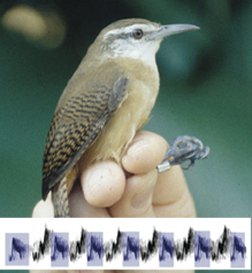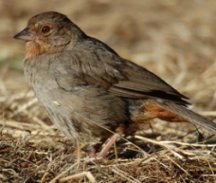As the morning mists rose on the slopes of Ecuador’s Pasochoa volcano, the burbling of plain-tailed wrens came through the bamboo thickets. Two researchers started their standard procedure of catching wrens, banding them, and letting them go. Soon, however, they were startled when a small cluster of wrens settled into a bush and began singing together. It turned out to be “one of the most complex singing performances yet described in a nonhuman animal,” says Nigel Mann.





Mann, of the State University of New York at Oneonta, and a colleague had gone to Pasochoa in the summer of 2002 as part of a team that was surveying of the 28-or-so species of the bird genus Thryothorus. That genus is famous for musical duets, in which a male and a female alternate phrases, sometimes so rapidly that it sounds like one song. Ecuador’s plain-tailed wrens (Thryothorus euophrys), relatives of North America’s Carolina wren, make a rhythmic, bubbling song together.
Most other wrens in this genus pair off and fiercely defend a territory. “If [four wrens] actually got within a few feet of each other, they’d be fighting,” says Mann. That’s why he and Kimberly A. Dingess of Indiana University at Bloomington were so surprised to find several plain-tailed wrens sharing a bush. “It took a few hours of wandering around for us to realize we had a group-living species,” Mann says.
This social oddity has musical consequences. Often, three or more birds sing—males, then females, then males, and so on—to produce what sounds like a single melody.
“It’s quite difficult to work out what’s Charlie’s contribution, what’s Mary’s,” Mann says.
Yet the scientists did work out the score. At rare moments in the several weeks of observation, Mann or Dingess picked up clues to which bird was singing when one singer perched closer to the microphone than the rest of the chorus did.
From these hard-won moments, the researchers realized that songs typically repeat four phrases: ABCDABCD…. Only males sing the As and Cs, and only females sing Bs and Ds. Each singer knows 25-to-30 variations on each of its two possible parts, and for each variation of A, a particular variation of B usually follows, as do particular Ds after Cs.
When more than two birds strike up a tune, they double up on the parts so precisely that if one bird stops singing, the tune keeps going. The males sing the same variation of A with precise timing, followed by the females chorusing the same version of B, then back to the males for the same C, and so on. The parts shift back and forth at least twice a second. For samples of sound files of duets, click here.
It’s the first four-part, synchronized chorus with alternating parts recorded outside human music, Mann, Dingess, and Peter J.B. Slater of the University of St. Andrews in Scotland report in the March 22 Biology Letters. And when one considers the split-second alternation, the birds’ singing surpasses human vocal virtuosity.
That’s the latest, most extreme example of duetting birds, a phenomenon that has fascinated birders for decades and inspired its own chorus of theorizing about what might drive such displays. Warning off rivals? Foiling flirtations? Checking musical passwords? In the past few years, field biologists have applied modern ideas about evolution to begin new tests of why duetters do it.
Singing double
Honks, squeaks, and melodic syllables can all be scored into avian duets. In at least 222 bird species worldwide, or about 3 percent of those known, two or more individuals routinely coordinate their vocalizations.
Duetting shows up in a range of bird families and takes many forms, says Michelle Hall of the Australian National University in Canberra. Although members of a mated pair typically alternate as they sing their parts, duos within some species sing in unison. In a few cases, two males vocalize together, or several birds form an ensemble, as among the plain-tailed wrens.
An ornithological sorrow of life in northern temperate zones is the scarcity of duetting birds. The few nontropical birds that perform together generally do simple numbers.
Ornithologists have described male and female Canada geese alternating honks. And Lauryn Benedict of the University of California, Berkeley is studying a duet of California towhees where male and females produce simultaneous, near-identical, squeal-like vocalizations that are used only in duets and never alone.
Most birds that duet—and the most interesting vocal interactions—come from somewhere other than northern temperate zones.
Among magpie-larks, which Hall studied during the 1990s, males and females sing solo as well as together. Common in Australian suburbs, the long-legged, black-and-white birds “can sound a little raucous,” says Hall. Either sex can initiate a duet, typically starting to repeat one of nine musical motifs, such as “peewee,” with a gap of a third to a half second between repetitions. On occasion, the mate inserts another motif in the gaps to make, for example, a “peewee o-wit peewee o-wit peewee” duet.
Male eastern whipbirds in Australia start a duet with a whistle and a sound like that of a cracking whip, and females chime in with several notes. Up and down Australia’s east coast, males sounded remarkably similar, but females had regional variations, report Amy Rogers of the University of Melbourne and Daniel Mennill of the University of Windsor in Ontario in the January Journal of Avian Biology.
In one of the rare male-male duets, two long-tailed manakins advertise the location of a courtship perch by simultaneously singing “Toledo.”
Male-manakin duos with the tightest coordination get the most visitors, report Jill Trainer of the University of Northern Iowa and her colleagues. However, only the dominant male of a singing pair does any mating. The second manakin can spend up to 10 years with no apparent reward but his increasing skill in singing along.
Why, oh why?
Over several decades, scientists have offered at least a dozen explanations for the purpose of avian duets. The theories have focused on the forest, the pair, or conflicts of interest between individual birds.
The abundance of duetting in the tropics inspired some of the early explanations. Scientists in the 1970s noted that dense tropical vegetation would make sound especially important for mates identifying each other or keeping in contact. Recently, theorists have suggested that tropical birds duet to stay in sync reproductively, despite limited seasonal cues such as changes in day length.
Other scientists have stressed the partnership. For example, in the 1980s, the “coyness hypothesis” proposed that birds that consummated their pairing only after the arduous job of learning to duet would have a stronger bond that would discourage extra-pair adventuring.
Yet other theorists have suggested that duetting enables a bird to judge its mate’s commitment to the partnership. Discouraging interlopers has been a popular theme, both in duetting to defend a territory and duetting to drive away a potential mate stealer.
Several current duet researchers trace their interest in the field to 1996 papers by Rachel Levin, now of Pomona College in Claremont, Calif. Her work challenged the idea that achieving coordinated singing is a difficult task.
Levin studied Panama’s bay wrens, which duet with rapid-fire, his-her alternation. When she kidnapped the mates of 10 bay wrens, the left-behind bird found a new mate and managed immediately to duet almost as well with the new partner as it had with the old.
Too often, these earlier theories treated a duet as a single, cooperative behavior performed for mutual advantage, Levin suggested. Because evolutionary forces act on individuals, Levin urged her colleagues to scrutinize the interests of individuals instead of happy pairs.
Levin’s work “reignited the excitement about duets,” says Mennill, who was inspired to take up the study of duetting in another tropical wren.
She’s/he’s mine
The current generation of duetting studies often compares his-and-her agendas. One possible agenda is the male’s clear interest in fathering the female’s chicks. He may be chiming in to the female’s song as a musical claim to paternity. If so, Hall says, then a male should duet more when his partner is fertile than when she’s not.
That idea didn’t hold up in magpie-larks. Hall found that a female tends to sing less when fertile and that a male is less likely to join in when his singing partner is fertile than when she’s not.
Buff-breasted wrens (Thryothorus leucotis) in Panama do something similar, says Sharon A. Gill, now at Princeton University. Males go “wop,” and at times, females smoothly interpose “weooh.”
Gill calculated females’ fertile periods by keeping track of when they laid eggs. The mates started duets less frequently during these times than when the females weren’t fertile, Gill reported in the April 2005 Behavioral Ecology and Sociobiology.
Males didn’t seem that concerned about paternity in general, Gill says. She didn’t find them sticking extra close to mates during fertile times. Nevertheless, only one of the 31 broods that she analyzed showed evidence of mixed parentage.
Even if duetting doesn’t guard paternity, either partner might have an agenda “to defend their partnership,” as Gill puts it. For example, consider the warbling antbirds in the Amazon (Hypocnemis cantator). Males sing solos, and, at times, females add girls-only song elements, report Nathalie Seddon and Joseph Tobias, both of the University of Oxford in England.
When the researchers played songs recorded from other warbling antbirds, both males and females were more likely to approach the speaker and to sing in response to same-sex solos than to male-female duets. When antbird couples hear recorded solos of a female, the resident male usually begins to sing. But then the resident female typically jumps in to duet sooner and more often than she does after recorded duets or male solos. That female is duetting to discourage same-sex interlopers, the researchers suggest in the January/February Behavioral Ecology.
African birds called tropical boubous (Laniarius aethiopicus) also show signs of mate guarding, but with a twist, Ulmar Grafe and Johannes Bitz of the University of Würzburg in Germany reported in 2004. When they played recorded male solos to pairs of birds, the female joined in to sing along. Then, in half of the six pairs studied, the female’s mate started overlapping the notes in the recorded male solo. Grafe and Bitz interpreted this as a male jamming the signal from a too-enticing male intruder.
My land
Territory, as well as mates, might be worth duetting for. As many of the tropical duetters do, rufous-and-white wrens (Thryothorus rufalbus) defend their turf year-round. Their duets are “fluty, haunting-sounding,” says Mennill, in contrast to the more-staccato bursts of other tropical wrens. In 70 percent of the rufous-and-white wrens’ duets, the females join a male song, rather than the male picking up on a female’s vocalization, Mennill reported in the January 2005 Auk.
The researcher moved around a pair of speakers, one broadcasting a male part in a duet and the other featuring the female, in an action mimicking that of a pair of wrens trespassing on various territories. The rightful territory owners approached the speakers with extra bursts of their own solo and duet songs. They wagged their tails and chattered harshly at the speakers, as they do when chasing off real invaders, Mennill reports in the January Animal Behaviour.
Other studies in different species have pointed out that duetting birds often sing loudly from easy-to-see perches, just as solo territorial songsters do. Soloists and duetters both match bits of their songs with those of potential intruders, a one-upmanship contest (SN: 12/18&25/04, p. 397; Available to subscribers at Song Fights).
Grafe and Bitz have even proposed that boubous sing a particular kind of duet to advertise to the neighborhood that they’ve trounced a rival. The scientists have broadcast songs to simulate an invading pair of boubous and then compared the duets of resident birds that fled from the invasion with duets of birds that held their ground. After the confrontation, the steadfast pairs used a particular configuration of male-and-female notes in a duet that fleeing birds didn’t use, the researchers reported in 2004.
The fury of territory defense led two researchers in 2004 to propose another function of duetting: distinguishing a fellow defender from an enemy. Black-bellied wrens (Thryothorus fasciatoventris) fuss and sing when researchers broadcast songs to mimic intruders, says David Logue of the University of Lethbridge in Alberta. He’s researching what he calls duet codes, rules saying that a male’s musical motif X goes with a female’s motif Y. Females “always blast out the right answer,” says Logue.
He and David Gammon of St. Edward’s University in Austin, Texas, suggested in 2004 that duetting offers a way for black-bellied wren females to make sure that their mates don’t attack them by mistake. The dense forests where these birds live distort sounds such as the “here I am” calls that other species use, says Logue. The wrens need an especially strong password system to tell friend from foe, he says.
Hall recounts anecdotes of attacks on intruders by cooperating birds. Purple-crowned fairy wrens, for example, spend much of their time near each other. “If one hops half-a-meter away, the other hops too,” she says. And when they hear recorded songs in stereo, they both fly to chasten one speaker and then move together to the second. Hall says that she hopes someone will explore how widespread such defensive coordination might be among duetters.
All the ideas about the function of duets need more testing, she adds.
As bird duets start to make sense, maybe they’ll shed light on other duetting species. Birds duet. Bugs duet. Even some primates do it.
All Together Now . . .
Employing terms and phrases such as “Toledo,” “wop,” “weooh,” and “peewee o-wit peewee o-wit peewee” bird duet researchers can be quite creative in describing the sound recordings used in their work. Since there is no substitute for the original, however, we thought we’d supply a sampling of the actual sound files, along with tips from the scientists about what to listen for. For ease of reference, we have provided a link here, which will open the main article, “Just Duet,” in a separate window.
From Nigel Mann:
Four-part chorus in plain-tailed wrens (Thryothorus euophrys).
p-t fig, 2nd.wav – This is a wren chorus of the type shown in the sonogram at right. Males sing the first and third elements (under blue bars) in each segment, and females interpose the second and fourth elements (under red bars). Double bars mean two birds are singing in unison (210 KB WAV file).
p-t long song.wav – This is a longer recording of the same species (1 MB WAV file).
From Lauryn Benedict:
Male-female duet in the California towhee, a rare temperate zone example of this behavior.
CALT song (161) 4-14-05.wav – This is an example of a typical male solo song (324 KB WAV file).
CALT duet (27&42) 6-28-04.wav – This duet of a male and female incorporates elements which males rarely sing alone. Females never sing other song types at all (453 WAV file).
From Daniel Mennill and Amy Rogers:
Eastern whipbird (Psophodes olivaceus) males start a duet with a whistle and a sound like a cracking whip.
The researchers include sonograms and sound files showing the regional variation found in female contributions to duets on their Web site at: http://web2.uwindsor.ca/courses/biology/dmennill/EAWH.html.
From Daniel Mennill:
Long-tailed manakins represent a rare example of a male-male duet.
Daniel Mennill’s Web site includes a page with the “toledo” duet by two courting males, as well as other phrases used in the courting display at: http://web2.uwindsor.ca/courses/biology/
dmennill/CostaRica/LTMA/CRLTMA.html.
From Sharon Gill:
Buff-breasted wren (Thryothorus leucotis) males and females trade parts back and forth within seconds.
Male-initiated duet.aif – An example of a duet initiated by the male (338 KB AIF file).
Female-initiated duet.aif – A duet started by the female of a mated pair (515 KB AIF file).
From Daniel Mennill:
Rufous-and-white wrens (Thryothorus rufalbus) defend their territory year-round.
A variety of solos and duets, which he describes as “fluty, [and] haunting-sounding” can be found on Dan Mennill’s Web site at: http://web2.uwindsor.ca/courses/biology/
dmennill/CostaRica/RWWR/CRRWWR.html.
From David Logue:
An example of a possible password code employed by black-bellied wrens (Thryothorus fasciatoventris).
To understand the duet code, Logue says, “Listen to the duet first, then the male and female songs that make it up, then the duet again. You can hear how in the duet, the female is responding to the male changing song type (1-2-1) by changing the song types she’s using as responses (also 1-2-1).”
Duet.wav – The full duet (438 KB WAV file).
Male song 1.wav – Male song type 1 (87 KB WAV file).
Female song 1.wav – Female song type 1 (84 KB WAV file).
Male song 2.wav – Male song type 2 (82 KB WAV file).
Female song 2.wav – Female song type 2 (72 KB WAV file).






